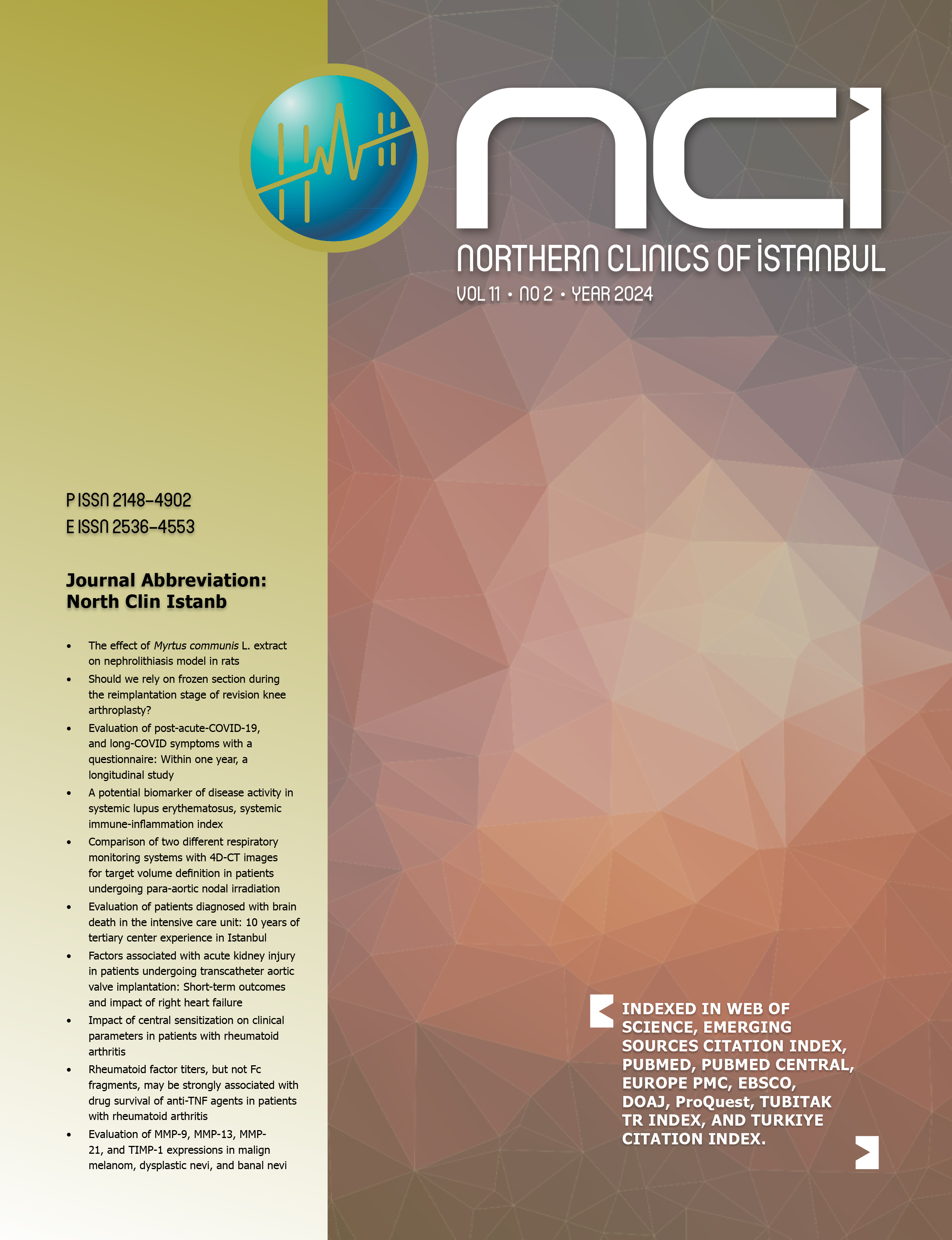Assessing the validity and reliability of the Turkish version of the Trunk Impairment Scale in stroke patients
Sinem Sağ1, Raikan Büyükavcı2, Füsun Sahin3, Mustafa Serdar Sag1, Beril Doğu4, Banu Kuran41Division of Rheumatology, Department of Physical Medicine and Rehabilitation, Sakarya University Faculty of Medicine, Sakarya, Turkey2Department of Physical Medicine and Rehabilitation, Inonu University Faculty of Medicine, Malatya, Turkey
3Department of Physical Medicine and Rehabilitation, Pamukkale University Faculty of Medicine, Denizli, Turkey
4Department of Physical Medicine and Rehabilitation, Sisli Hamidiye Etfal Training and Research Hospital, Istanbul, Turkey
INTRODUCTION: To determine the validity and reliability of the Turkish version of the Trunk impairment scale (TIS), used in the evaluation of somatic, motor, and coordination disturbances in stroke patients, and provide a culturally adapted version for use in the Turkish population.
METHODS: A total of 80 patients who were either hospitalized at our facility and rehabilitated for stroke or admitted at our outpatient clinics were included in this study. Reliability was evaluated by the internal consistency (Cronbach α) and test reproducibility [intra-class correlation coefficient (ICCC)] methods, and validity was evaluated by the correlation between subgroups and the total scores of the TIS and Berg Balance Scale (BBS), Brunnstrom phases, Barthel index (BI), Rivermead mobility index (RMI), and Short Form-36 (SF-36) scores.
RESULTS: The mean age of the patients was 63.00±12.1 years. Out of a total of 80 subjects, 34 were female and 46 were male. The reliability of the scale was evaluated by the internal consistency, inter- and intra-observer reliability, and test reproducibility. The findings showed that the Turkish form of the scale was reliable at a good level. The test values were as follows; Cronbach α: >0.70, ICCC: 0.9691, subgroups and total score comparison: 0. The correlation between TIS and BBS was considerably high in the validity analysis (p<0.001). Further, significant associations among the BI, RMI, KF-36, Brunnstrom, and TIS scores were found (p<0.001), which indicate the structural validity of this scale.
DISCUSSION AND CONCLUSION: TIS is a scale used in measuring the motor derangement that develops after a stroke. It has sufficient reliability, internal consistency, and validity for use in clinical practice and stroke investigations. Our study has shown that TIS used for the evaluation of body balance is valid and reliable for the Turkish population.
İnmeli Hastalarda Gövde Bozukluk Skalasının Türkçe Geçerlilik Ve Güvenilirliğinin Gösterilmesi
Sinem Sağ1, Raikan Büyükavcı2, Füsun Sahin3, Mustafa Serdar Sag1, Beril Doğu4, Banu Kuran41Sakarya Üniversitesi Tıp Fakültesi,FTR Anabilim dalı,Romatoloji Bilimdalı,Sakarya,Türkiye2İnönü Üniversitesi Tıp Fakültesi,FTR Anabilimdalı,Malatya,Türkiye
3Pamukkale Üniversitesi Tıp Fakültesi,FTR Anabilimdalı,Denizli,Türkiye
4Şişli Hamidiye Etfal Eğitim ve Araştırma Hastanesi,İstanbul,Türkiye
GİRİŞ ve AMAÇ: İnmeli hastaların, gövdede oluşan motor ve koordinasyon bozukluklarını değerlendirmede kullanılan Gövde Bozukluk Skalasının (GBS) Türkçe geçerlilik ve güvenilirliğini belirlemek ve Türk toplumunda kullanılabilmesi için kültürel uyumu sağlamak.
YÖNTEM ve GEREÇLER: : Çalışmaya kliniğimizde yatarak inme rehabilitasyonu yapılan ve polikliniğimize başvuran toplam 80 inmeli hasta alındı. Güvenilirlik, iç tutarlılık (Cronbach α) ve test-tekrar test etme [sınıf içi korelasyon katsayısı (SİKK)] yöntemleri ile; geçerlilik ise GBS nin alt grup ve total skorları ile Berg Denge Ölçeği (BDÖ), Brunnstrom evreleri, Barthel indeksi (Bİ), Rivermead mobilite indeksi (RMİ) ve Kısa Form-36 (KF-36) skorları arasındaki korelasyonla değerlendirildi.
BULGULAR: Hastaların yaş ortalaması 63,00 ± 12,1 yıl olup, 34 ü kadın 46 sı erkek hastadan oluşmakta idi. Ölçeğin güvenilirliği iç tutarlılık, değerlendirici içi ve değerlendiriciler arası güvenilirlik ve test-tekrar test güvenilirliği ile değerlendirilmiş ve elde edilen bulgular ölçeğin Türkçe formunun iyi derecede güvenilir olduğunu göstermiştir. Tüm alt grup ve total skor için Cronbach α değerleri >0,70, SİKK 0,969- 1,0 olarak bulundu. Geçerlilik analizinde GBS nin BDÖ ile korelasyonu oldukça yüksek (p<0,001)bulunmuştur. Ayrıca hastaların Barthel indeksi, Rivermead mobilite indeksi, KF-36, Brunnstrom ile GBS ölçeğinden aldıkları puanlar karşılaştırıldığında anlamlı ilişkiler saptanmış (p<0,001), bu da ölçeğin yapısal olarak geçerli olduğunu göstermiştir.
TARTIŞMA ve SONUÇ: Gövde Bozukluk Skalası felç sonrası gövdede oluşan motor bozuklukları ölçen bir ölçektir. Klinik pratikte ve inme araştırmalarında kullanım için yeterli güvenilirliğe, iç tutarlılığa ve geçerliliğe sahiptir. Bizim çalışmamız inmeli hastalarda gövde dengesini değerlendirmek için uygulanan Gövde Bozukluk Skalasının Türk toplumunda geçerli ve güvenilir olduğunu göstermiştir.
Manuscript Language: English





















